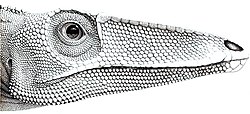| Forest Sandstone | |
|---|---|
| Stratigraphic range: Hettangian-Sinemurian ~ | |
 | |
| Type | Geological formation |
| Unit of | Karoo Supergroup Upper Karoo Group |
| Underlies | Batoka Formation |
| Overlies | Pebbly Arkose Formation |
| Lithology | |
| Primary | Sandstone |
| Location | |
| Coordinates | 20°00′S28°24′E / 20.0°S 28.4°E |
| Approximate paleocoordinates | 35°00′S5°06′E / 35.0°S 5.1°E |
| Region | South-central Africa |
| Country | Botswana Zambia Zimbabwe |
| Type section | |
| Named for | Forests of Nyamandlovu District, Zimbabwe |
| Named by | A.M. MacGregor, Zimbabwe Geological Survey |
The Forest Sandstone is a geological formation in southern Africa, dating to roughly between 200 and 190 million years ago and covering the Hettangian to Sinemurian stages of the Jurassic Period in the Mesozoic Era. [1] As its name suggests, it consists mainly of sandstone.
Contents
- Geology
- Description
- Extent
- Deposition
- Stratigraphy
- Fossil content
- Economic importance
- Hydrogeology
- References
Fossils of the prosauropod dinosaur Massospondylus and the primitive sauropod Vulcanodon have been recovered from the Forest Sandstone.


